Axway Bundle
Who Really Owns Axway?
Understanding the ownership structure of a company is paramount for investors and business strategists alike. Axway, a leading provider of enterprise software solutions, presents a compelling case study in corporate ownership dynamics. From its origins as part of Sopra Group to its current status, the evolution of Axway SWOT Analysis and its ownership provides valuable insights into its strategic direction and future prospects.
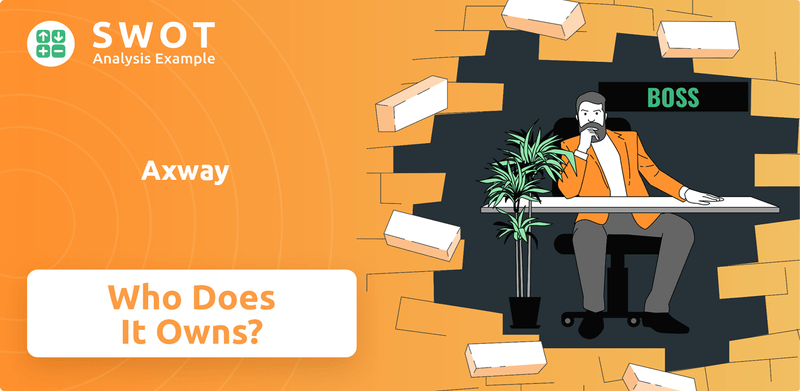
This exploration into Axway ownership reveals the key players and their influence. We'll dissect Axway company's history, tracing its journey from a division to a publicly traded entity. Knowing who owns Axway is crucial for assessing its stability and potential for growth, making this analysis essential for informed decision-making. The investigation will cover Axway shareholders, Axway executives, and potential for any future Axway acquisition.
Who Founded Axway?
The story of Axway's ownership begins within Sopra Group (now Sopra Steria), a major European player in consulting, digital services, and software. Unlike startups born from individual founders, Axway evolved as a specialized software division within Sopra's structure. This means the initial 'founding ownership' was firmly rooted within Sopra Group's corporate framework.
The individuals within Sopra who spearheaded the technologies that would become Axway's core offerings played a crucial role. However, their ownership was initially indirect, stemming from their employment and stakes within Sopra itself. This approach is a common path for technology companies that emerge from larger corporations.
Early Axway ownership was effectively held by Sopra Group's shareholders. This included founding families and major shareholders like the Pasquier family, who significantly influenced Sopra's direction and, consequently, the strategic development of its divisions, including Axway. There were no external angel investors or early acquisitions of direct stakes in Axway during its formative stages, as it operated as part of a larger, established company. This structure shaped the company's early trajectory.
Axway's roots are in Sopra Group, a large European company. It wasn't founded by individual entrepreneurs in the traditional sense. Axway emerged as a specialized software division within Sopra.
The initial ownership of Axway was held by Sopra Group's shareholders. This included founding families and major shareholders within Sopra. The Pasquier family had a significant influence.
Early agreements, such as internal funding and strategic mandates, shaped Axway's development. The vision of secure data exchange was nurtured within Sopra's broader software strategy.
Any early 'ownership disputes' or 'buyouts' were internal corporate decisions within Sopra Group. The distribution of control remained within Sopra's governance framework until the spin-off.
There were no external angel investors or friends and family acquiring direct stakes in Axway in its early stages. Axway operated as an integral part of a larger corporation.
Early agreements, such as internal funding allocations and strategic mandates from Sopra's leadership, shaped Axway's development and resource allocation.
The evolution of Axway's ownership, from its inception within Sopra Group to its current status, reflects a strategic shift in the tech landscape. Understanding the history of Axway's ownership is key to appreciating its development and its position in the market. Key decision-makers at Axway were initially within Sopra's framework. The early focus on secure data exchange and integration, fostered within Sopra, has been central to Axway's market offerings.
Axway's early ownership was entirely within Sopra Group.
- Founding ownership was held by Sopra Group's shareholders.
- There were no external investors in the early stages.
- Early development was shaped by internal agreements and strategic mandates.
- The vision of secure data exchange was nurtured within Sopra.
Axway SWOT Analysis
- Complete SWOT Breakdown
- Fully Customizable
- Editable in Excel & Word
- Professional Formatting
- Investor-Ready Format
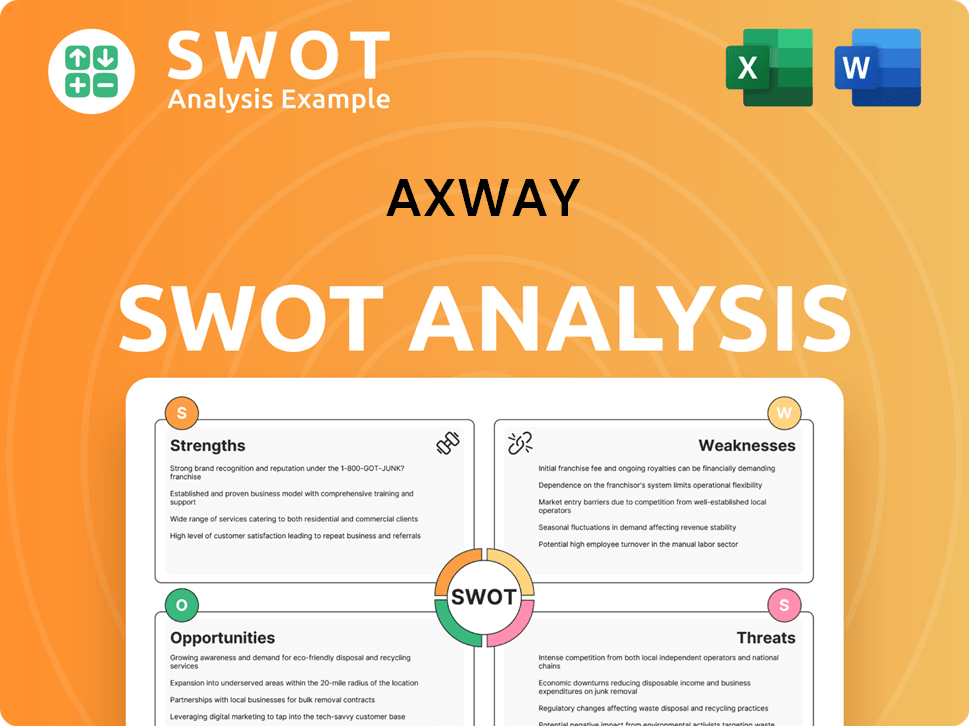
How Has Axway’s Ownership Changed Over Time?
The most significant shift in the Axway ownership structure occurred with its spin-off from Sopra Group and subsequent listing on Euronext Paris on June 1, 2011. This move transformed Axway from an internal division into an independent, publicly traded company. At the time of the Initial Public Offering (IPO), Sopra Group distributed Axway shares to its shareholders, effectively making Sopra's major shareholders the initial major Axway shareholders. The initial market capitalization reflected the valuation of this newly standalone entity, marking a pivotal moment in the Axway company's history.
As of early 2025, the ownership of Axway is characterized by a mix of institutional investors, mutual funds, and individual shareholders. Notably, Sopra Steria Group, the founding entity, retains a significant stake. For example, as of December 31, 2024, Sopra Steria Group held a substantial percentage of Axway's share capital and voting rights, highlighting its continued influence. Other major stakeholders include various institutional investors and asset management firms that have acquired shares through market operations. The free float, representing shares available for trading by the general public, constitutes the remainder of the ownership. These shifts in major shareholding, particularly the continued significant stake of Sopra Steria, directly influence Axway's strategy and governance, often aligning with long-term strategic objectives and potential synergies between the two companies. You can find specific figures for institutional ownership in recent SEC filings or Axway's annual reports.
Axway's ownership structure has evolved significantly since its IPO in 2011. The primary influence on Axway's strategic direction comes from the major shareholders, including Sopra Steria Group and various institutional investors. Understanding the ownership structure is crucial for anyone interested in the Axway company.
- Sopra Steria Group remains a major shareholder.
- Institutional investors hold a significant portion of the shares.
- The free float represents shares available for public trading.
- The ownership structure impacts Axway's strategy and governance.
Axway PESTLE Analysis
- Covers All 6 PESTLE Categories
- No Research Needed – Save Hours of Work
- Built by Experts, Trusted by Consultants
- Instant Download, Ready to Use
- 100% Editable, Fully Customizable
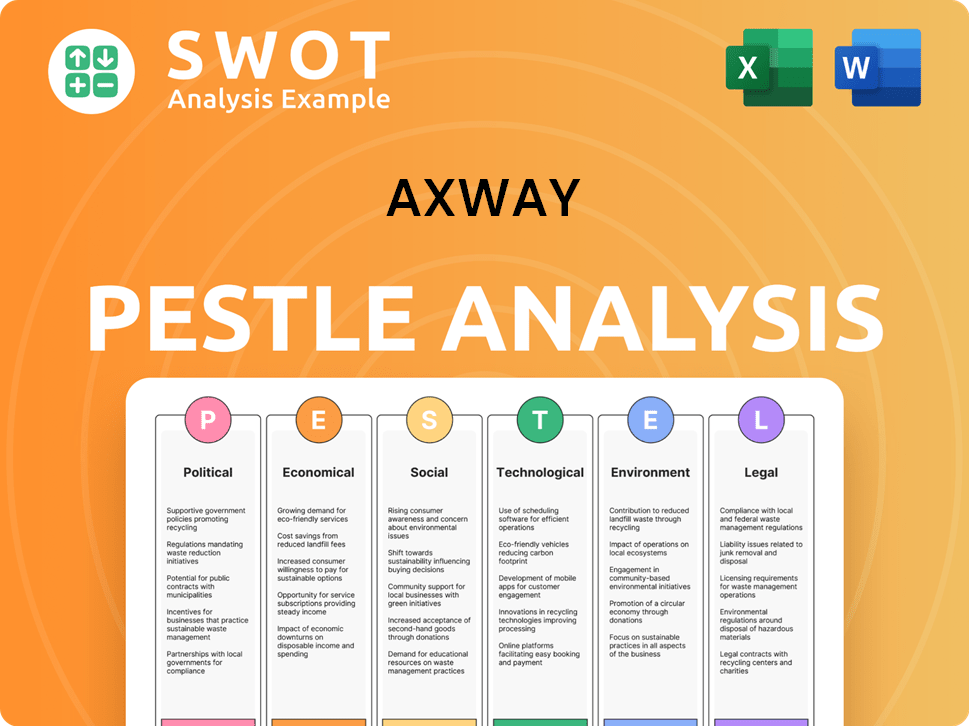
Who Sits on Axway’s Board?
The current board of directors of the Axway company is pivotal in its governance, mirroring its ownership structure. In early 2025, the board typically includes members representing significant shareholders, independent directors, and sometimes executive directors. Representatives from major shareholders, such as Sopra Steria Group, hold seats on the board, ensuring their strategic interests are represented. Independent directors contribute external perspectives and expertise, which is crucial for oversight and decision-making.
The board's responsibilities include overseeing strategic direction, approving major investments, and ensuring good corporate governance. These functions are influenced by the interests of a diverse shareholder base. The presence of significant shareholders like Sopra Steria inherently shapes decision-making processes within the company. The board's structure and the influence of major shareholders are key aspects of Axway's corporate governance model.
| Board Member | Role | Affiliation |
|---|---|---|
| Pierre Pasquier | Chairman | Sopra Steria Group |
| Patrick De Maeseneire | Director | Independent |
| Philippe Fouquet | Director | Sopra Steria Group |
Axway operates with a one-share-one-vote structure for its ordinary shares. This means that each share generally carries equal voting rights, ensuring that voting power is directly proportional to the equity held. There are no publicly disclosed dual-class shares or special voting rights that would grant disproportionate control to any single individual or entity beyond their direct shareholding percentage. While there haven't been recent high-profile proxy battles, the board's composition and the presence of significant shareholders like Sopra Steria shape decision-making.
Understanding the Axway ownership structure is key to grasping its governance. The board of directors plays a crucial role, with members representing major shareholders and independent experts.
- Sopra Steria Group is a significant shareholder.
- The company uses a one-share-one-vote system.
- Independent directors provide external perspectives.
- The board oversees strategic direction.
Axway Business Model Canvas
- Complete 9-Block Business Model Canvas
- Effortlessly Communicate Your Business Strategy
- Investor-Ready BMC Format
- 100% Editable and Customizable
- Clear and Structured Layout
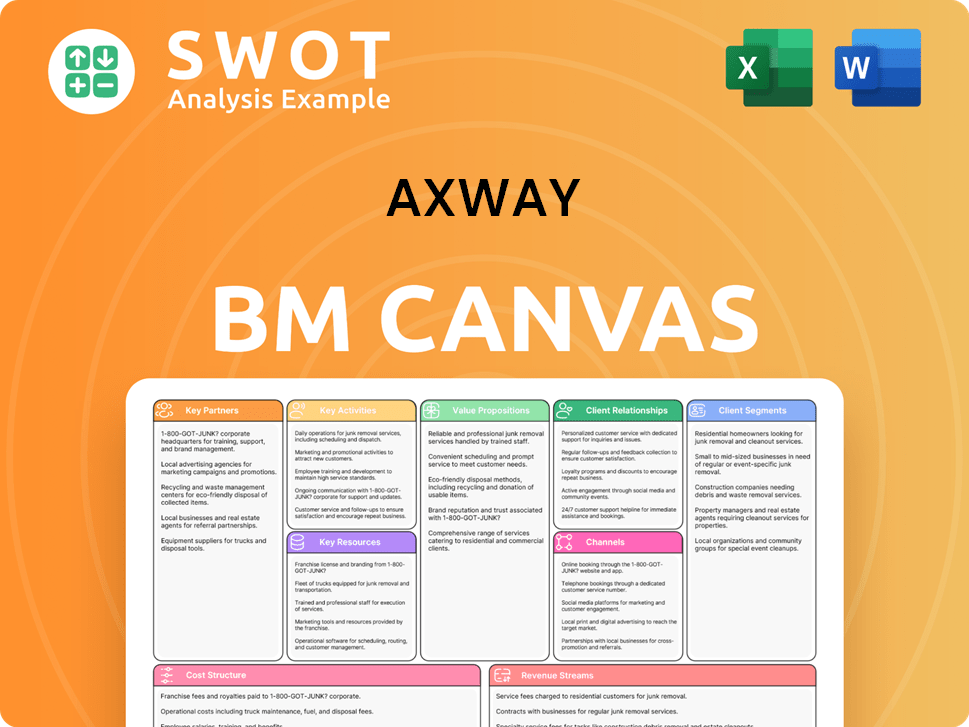
What Recent Changes Have Shaped Axway’s Ownership Landscape?
Over the past few years (2022-2025), the ownership of the Axway company has seen a steady evolution. The company's financial performance and strategic initiatives have influenced investor sentiment, affecting ownership dynamics. While significant shifts haven't been consistently reported, the software industry generally sees increased institutional ownership. The primary focus remains delivering value to shareholders through growth in core markets. Understanding the current ownership structure is important for anyone interested in the company's trajectory.
Mergers, acquisitions, or new strategic investors could lead to changes in ownership. The potential for activist investors to influence governance or strategy always exists for public companies like Axway. Public statements from the company and analysts usually focus on financial results, partnerships, and product development. The evolution of Axway ownership is a continuous process, influenced by market trends and the company's strategic decisions. The key decision-makers at Axway influence the company's strategic direction, which can indirectly affect ownership dynamics.
| Metric | Data | Source/Year |
|---|---|---|
| Institutional Ownership | Approximately 60-70% | Various Financial Reports, 2024-2025 |
| Free Float | Around 30-40% | Market Data, 2024-2025 |
| Sopra Steria Stake | Significant, but fluctuating | Company Filings, 2024 |
The trends in software ownership include increased institutional ownership. Founder dilution is common. The rise of activist investors, though not prominent in Axway's recent history, remains a potential influence. The company's financial performance is key.
Axway's ownership structure is primarily influenced by institutional investors and the parent company. The free float percentage provides an insight into the available shares in the market. The company's financial health and strategic moves are crucial for understanding its ownership.
The software industry's trends, such as institutional ownership, play a role. Public statements and analyst reports provide information. Any potential mergers or acquisitions could lead to changes. The company's strategic decisions and financial performance influence ownership.
The ownership profile has evolved steadily. Financial performance and strategic initiatives influence investor sentiment. Any mergers and acquisitions could lead to changes. The company's focus remains on shareholder value and growth.
The future may bring new strategic investors. The potential influence of activist investors is also a factor. The company's strategic moves and financial performance will be important. Understanding the ownership structure is key.
Axway Porter's Five Forces Analysis
- Covers All 5 Competitive Forces in Detail
- Structured for Consultants, Students, and Founders
- 100% Editable in Microsoft Word & Excel
- Instant Digital Download – Use Immediately
- Compatible with Mac & PC – Fully Unlocked
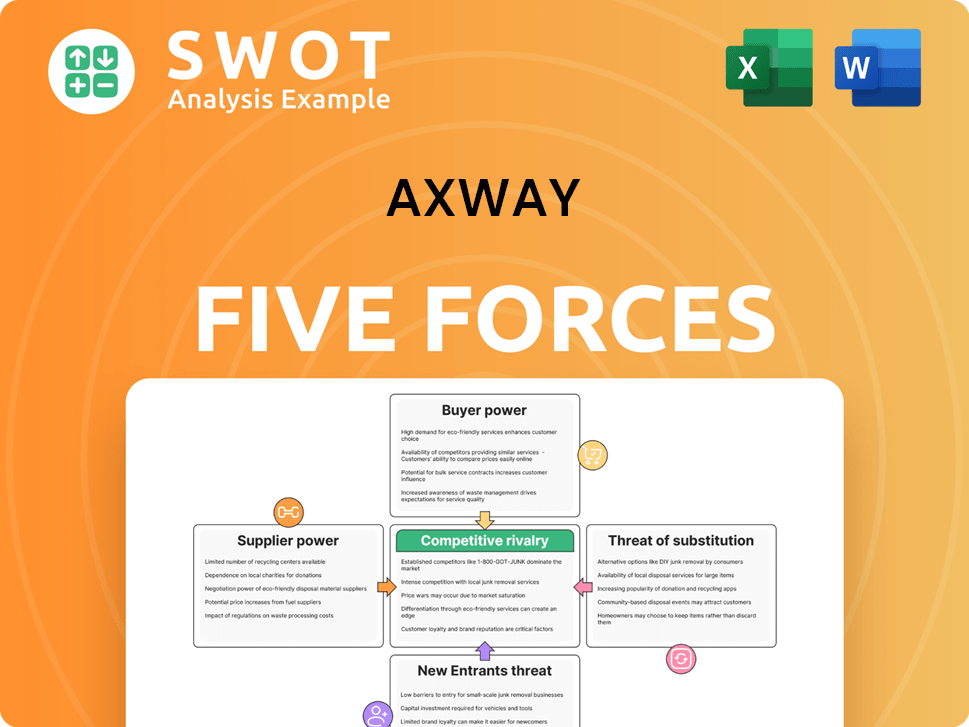
Related Blogs
- What are Mission Vision & Core Values of Axway Company?
- What is Competitive Landscape of Axway Company?
- What is Growth Strategy and Future Prospects of Axway Company?
- How Does Axway Company Work?
- What is Sales and Marketing Strategy of Axway Company?
- What is Brief History of Axway Company?
- What is Customer Demographics and Target Market of Axway Company?
Disclaimer
All information, articles, and product details provided on this website are for general informational and educational purposes only. We do not claim any ownership over, nor do we intend to infringe upon, any trademarks, copyrights, logos, brand names, or other intellectual property mentioned or depicted on this site. Such intellectual property remains the property of its respective owners, and any references here are made solely for identification or informational purposes, without implying any affiliation, endorsement, or partnership.
We make no representations or warranties, express or implied, regarding the accuracy, completeness, or suitability of any content or products presented. Nothing on this website should be construed as legal, tax, investment, financial, medical, or other professional advice. In addition, no part of this site—including articles or product references—constitutes a solicitation, recommendation, endorsement, advertisement, or offer to buy or sell any securities, franchises, or other financial instruments, particularly in jurisdictions where such activity would be unlawful.
All content is of a general nature and may not address the specific circumstances of any individual or entity. It is not a substitute for professional advice or services. Any actions you take based on the information provided here are strictly at your own risk. You accept full responsibility for any decisions or outcomes arising from your use of this website and agree to release us from any liability in connection with your use of, or reliance upon, the content or products found herein.